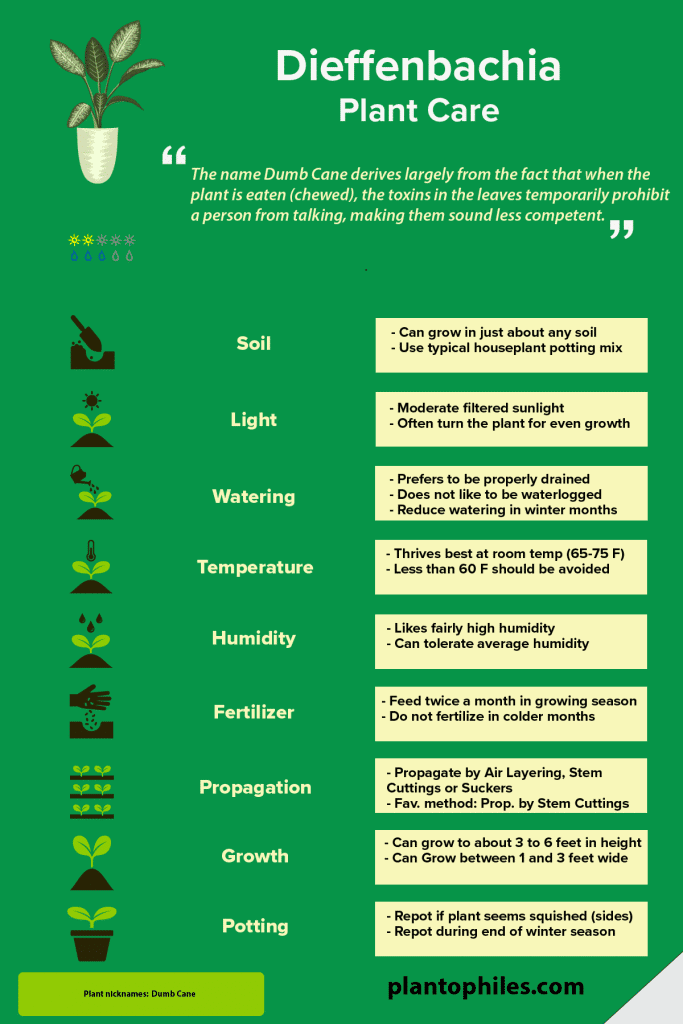Chosen for its showy foliage, the Dieffenbachia plant (Dumb Cane) is a popular evergreen houseplant used in many homes.
This tropical addition is well-loved for its simple care. It is forgiving and grows well even under suboptimal conditions.
This Dieffenbachia care guide will give you all the instructions to keep a Dieffenbachia plant thriving.
Find a free Dieffenbachia infographic at the end of this article.

Dieffenbachia Takeaways
| Species | Dieffenbachia |
| Synonyms | Dumb cane, Leopard lily, Mother-in-law plant, Giant dumb cane, Exotica perfection, Tropic snow, Camille, Compacta, Delilah, Marianne |
| Family | Araceae |
| Genus | Dieffenbachia |
| Growth | Compact, bushy |
| Height | 6 feet |
| Width | 3 feet |
| Soil | Well-draining soil mix |
| Watering | Water every 7 to 14 days |
| Light | Bright indirect |
| Temperature | 65 to 75°F |
| Humidity | 40-60% |
| Fertilizer | Fertilize 1 times per month |
| Propagation | Stem cuttings |
| Toxicity | Toxic to cats, dogs, horses and humans |
Dieffenbachia Care Indoors
To care for Dieffenbachia, provide a temperature between 65-75°F (18-24°C) and >60% humidity. Water once the soil’s top 2-3” (5-7.6cm) has dried out. Keep the soil slightly moist and provide bright indirect sunlight. It tolerates lower light but will grow slower. Fertilize twice a month in Spring and Summer.

Table of Contents
Dieffenbachia Care Tips
Dumb Cane Care Video
The Dieffenbachia plant, or Dumb Cane, can grow just fine with low light yet prefers a good amount of indirect light.
Don’t let that scare you. This houseplant is easy to care for when given the right parameters.
Soil
Dieffenbachia grows best in 1 part of perlite to 2 parts of peat moss.
One easy aspect of Dieffenbachia is that it can grow in just about any soil, according to the University of Florida.
Keep in mind that they do like to be placed in soil that is both moist and properly drained.
Using a typical houseplant potting mix is sufficient.
When in doubt, mix 1 part of perlite with two parts of peat moss.
The Dumb Cane originated in tropical America, where the soil had a constant layer of mist.
Light
For Dieffenbachia care, provide bright indirect sunlight.
Direct sunlight might burn and scorch the leaves.
A few hours (3-4 hours) of direct sunlight in the morning is fine.
This is usually what you get from an eastern-facing window.
Considering the natural habitat of the Dieffenbachia plant, you can imagine these individuals being surrounded by expansive trees with large leaves.
Dumb Cane in the wild inhabits forests that have lower light.
To imitate these growing conditions, keep your Dieffenbachia plant in a spot where indirect sunlight can reach it.
Plant lovers have noticed these individuals shoot up when placed in partially shaded areas.

Watering
Water Dieffenbachia about once a week and keep the soil slightly moist. Water once the top 2-3 inches of the soil has dried out.
The Dieffenbachia plant prefers to be well-saturated yet also properly drained.
The University of Connecticut suggests keeping the soil slightly moist for Dieffenbachia.
The best practice is to add water and check the top 2 to 3 inches of soil (5-7.6cm).
Do not add more water until this section of the soil is dried out.
Just ensure not to overwater, or you may have root rot.
Also, remember that water requirements should be reduced during the winter months.
Temperature
The ideal temperature for Dieffenbachia is 65-75°F (18-24°C).
Being a well-sought-after houseplant, the Dumb Cane can thrive in an average room temperature of about 65 to 75 degrees Fahrenheit.
They can even live when placed in a room that is about 80 degrees Fahrenheit.
These plants do not fare well with temperatures below 60 degrees Fahrenheit. In these living conditions, you may see the leaves of Dieffenbachia start to turn yellow.
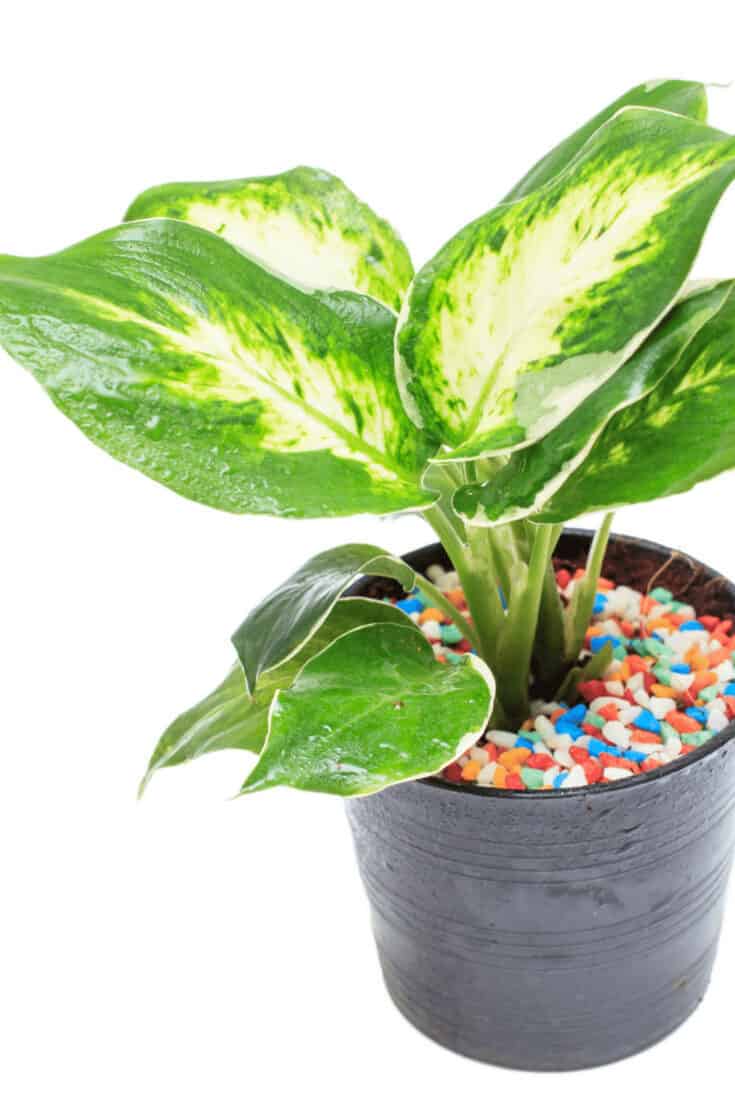
Humidity
Provide >60% humidity for a Dieffenbachia for it to thrive.
As mentioned earlier, the Dieffenbachia plant is a fan of a room with fairly high humidity.
This is not a deal-breaker as they adjust well to the average indoor humidity.
You can keep your Dumb Cane happy and healthy through a routine misting on top of the occasional watering. Just ensure the leaves do not stay wet for more than 30min.
A better way to keep an increased humidity level is to use a humidifier or keep plants closely together. This way, the humidity around Dieffenbachia is increased.
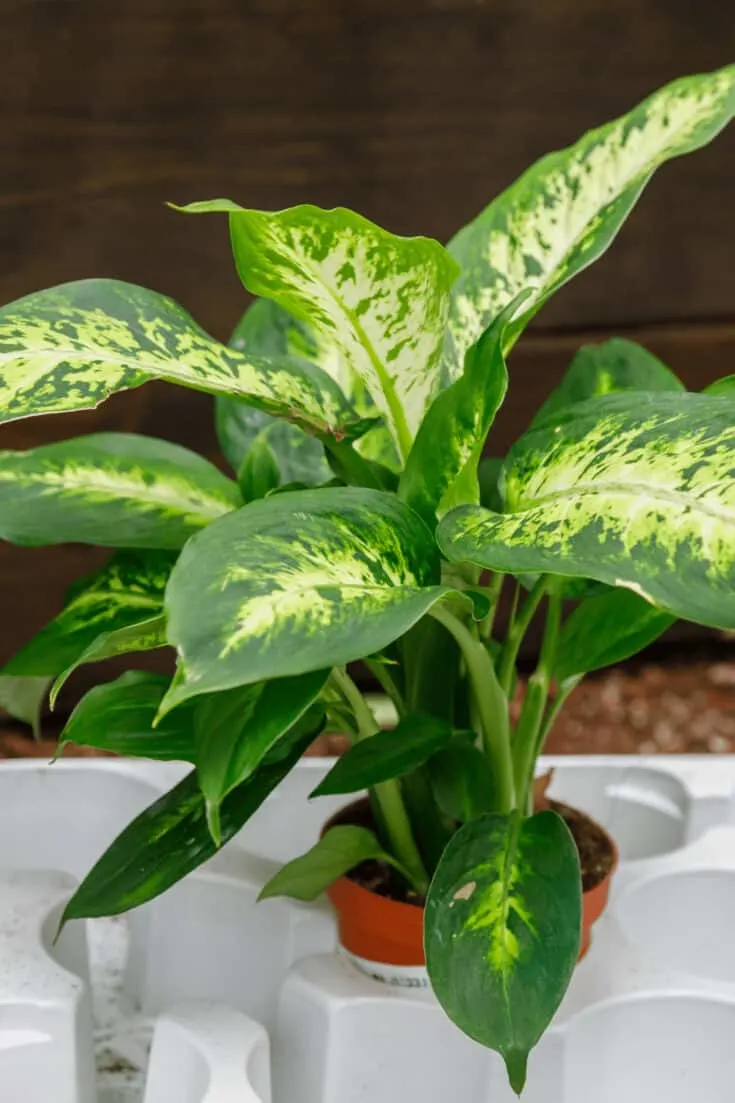
Fertilizer
Fertilize twice a month in spring and summer using a balanced liquid fertilizer with an NPK of 10-10-10 or 20-20-20.
When tending to your tropical houseplant in the growing season, supply your Dumb Cane with a good amount of fertilizer.
Fellow Dieffenbachia growers have noticed that these plants thrive best when adding fertilizer twice a month.
For the colder months, fertilizer is not necessary.
Most recommend not feeding your plant during this time.
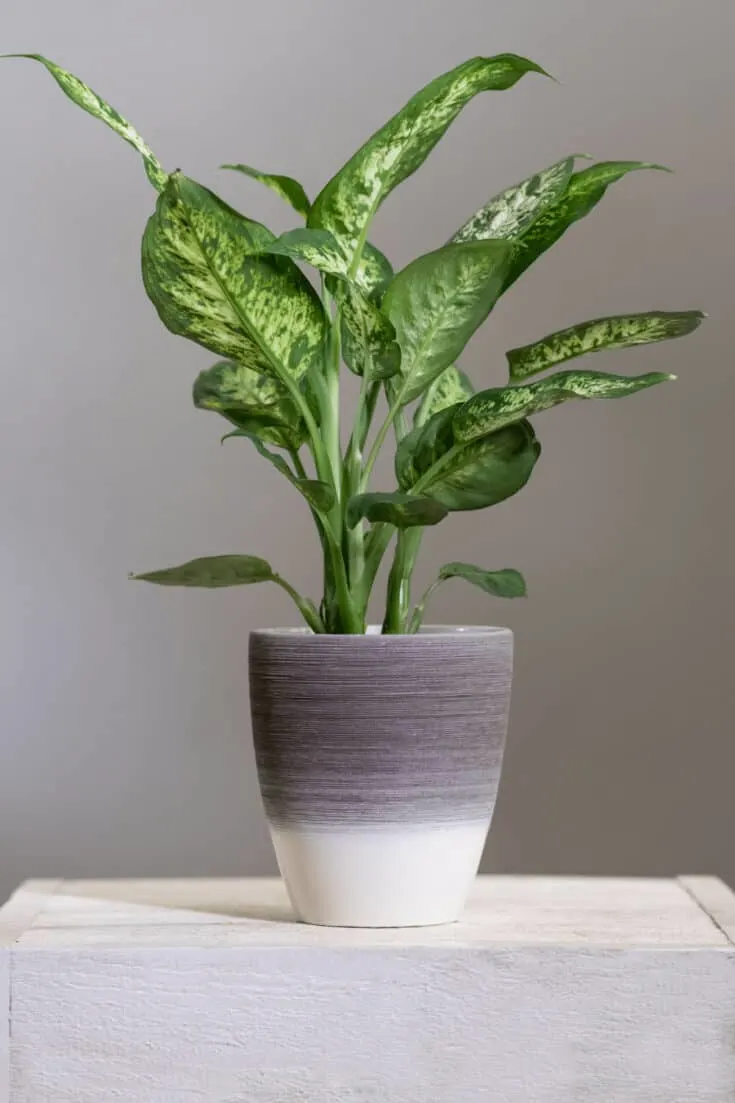
Growth
Dieffenbachia can grow 4 to 6 feet in height (120-180cm).
Several Dumb Cane varieties vary greatly in their physical appearance.
These plants reach 3 to 6 feet long (91-183cm).
As for their width, they typically grow between 1 and 3 feet wide.
The largest Dieffenbachia plant, the Tropical Tiki (Dieffenbachia maculata) grows to a staggering 6 feet (183cm) with a width of 5 feet (150cm).
It is quite the household statement with silver leaves and mottling of green and white hues!
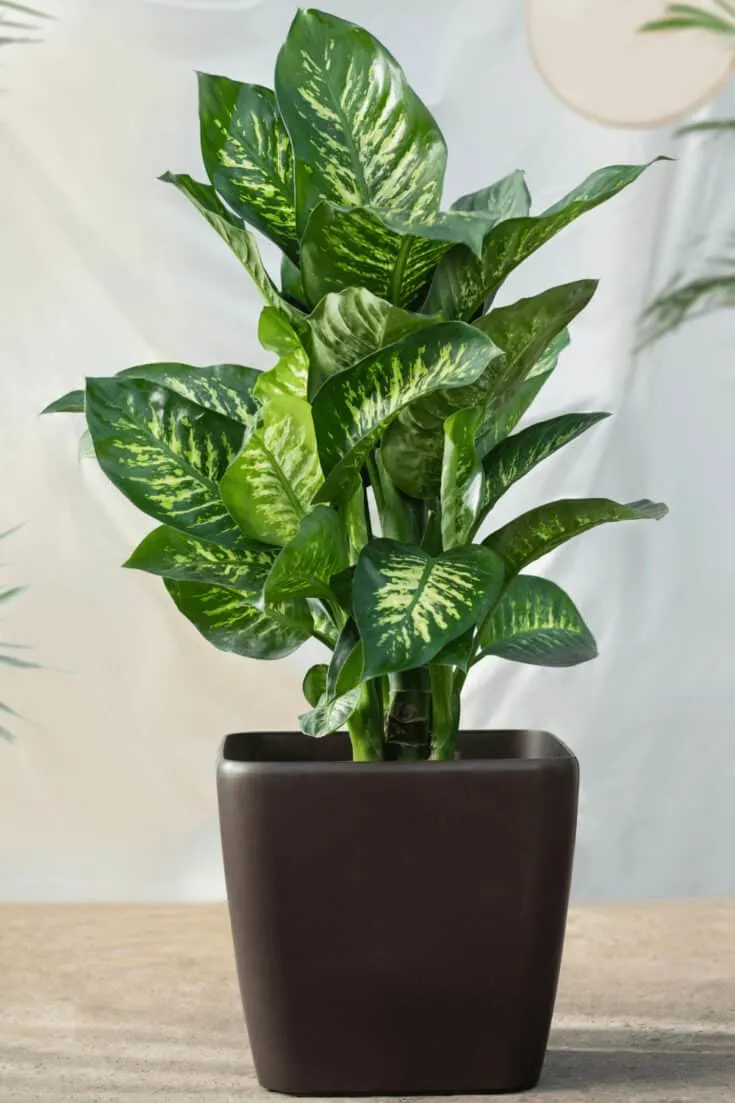
Blooms
The blooms of the Exotica perfection consist of a spathe and spadix. This is the case for all Araceae or Aroid plants. The flowers aren’t particularly showy. They consist of a modified leaf, the spathe, and the spadix. The spadix is like a stick in the middle. It consists of tiny flowers.
Potting
Due to the growth rate of Dieffenbachia picta, it is advised that you check on it regularly.
As time passes, the soil begins to break down until there is hardly any breathing room for the roots.
If the plant seems squished on the sides, repot it in a pot slightly larger than the existing home.
The best time to repot a Dieffenbachia plant is during the end of the winter season as the plant begins to grow.
WATERING YOUR DIEFFENBACHIA
PLANT THE RIGHT WAY
One of the most common mistakes made with a Dieffenbachia plant is that people tend to overwater.
This plant is one of the easier tropical houseplants to care for, yet it needs a consistent watering regimen.
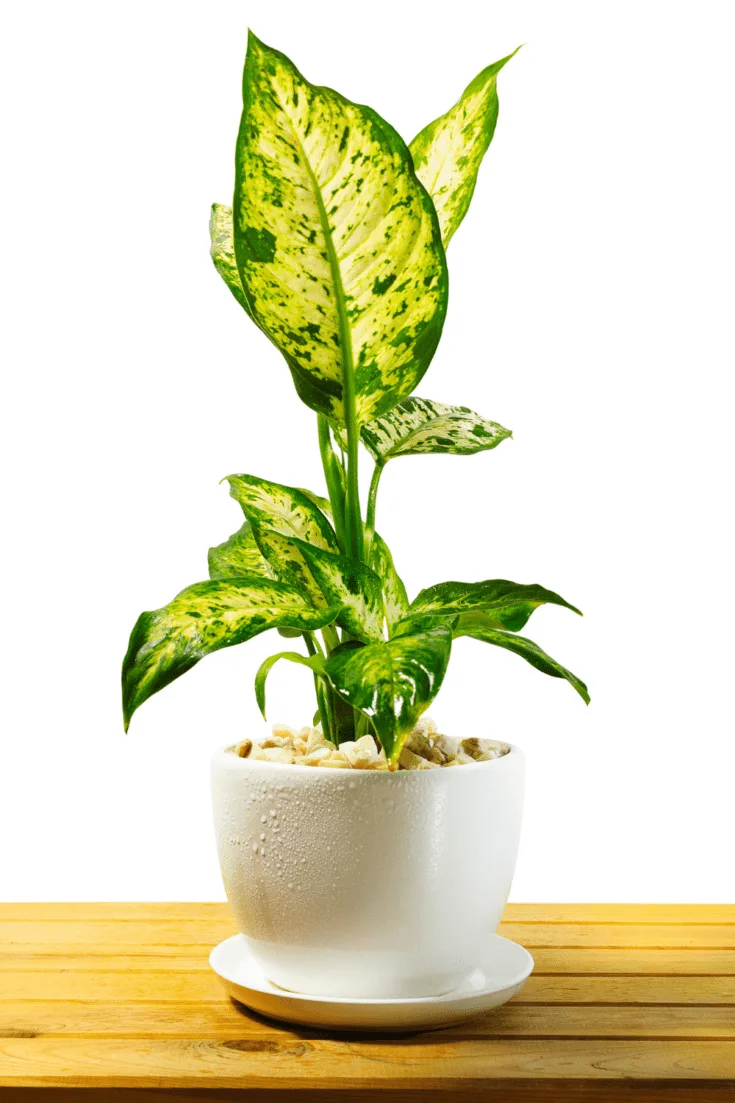
WHERE TO WATER
These plants prefer to be placed in moist soil, not soggy or overwatered.
For the best results, horticulturists have suggested watering at the base of your Dumb Cane plant.
That way, all the added moisture is deposited directly into the soil.
WHEN TO WATER
One of the most critical steps in caring for a Dieffenbachia plant is the watering routine that you implement.
Considering when to give your ample water is key.
To avoid overwatering, you should only add water when the top layer of soil is completely dried out.
This generally includes the top 2 to 3 inches of soil depth.
If your Dieffenbachia plant cannot drain properly, you may want to solve that problem first.
Adding a drainage hole to the bottom of the pot is a great start.
Once you make this adjustment, you can implement a routine watering schedule.
Finding the best length between watering episodes takes a bit of time.
Some even recommend completely drenching the soil once the plant is dried out.
Do not try this method unless you have a pot that can drain the excess liquid.
When in doubt, it is best to add the water slowly until the top 2 to 3 inches of soil is moderately dry.
THE RIGHT WATER QUALITY
Some plants require rainwater to grow. The Dumb Cane prefers a certain temperature.
Watering a Dieffenbachia plant with lukewarm water yields the best results.
The most important water requirement is not in the quality but quantity.
It is best to focus on the possible risk of overwatering rather than what type of water you use on your houseplant.
DIEFFENBACHIA PRUNING
As with most plants, the act of pruning can be beneficial for both you and your tropical addition.
You may not want to snip away at those flashy leaves, but remember that it will keep your plant healthy and happy.
WHEN TO PRUNE YOUR PLANT
The Dieffenbachia plant is known for how broad the leaves can get.
This foliage grows so tall that the leaves appear bare as it grows.
But where do you start cutting without damaging the plant?
HOW TO PRUNE YOUR DUMB CANE?
Before you even start pruning your Dieffenbachia plant, it is best to be prepared with the proper attire.
The sap produced by these leaves is quite poisonous. To avoid becoming sick, always wear gloves.
Once ready, begin by cutting the stems at roughly a 45-degree angle.
The new growth will begin to develop directly below the newly made incision.
You can even keep these cuttings for a new plant entirely! Once you’ve made the desirable pruning efforts, water your plant.
Because this plant is poisonous, sterilize your tools and thoroughly wash your hands.
PROPAGATION OF THE DIEFFENBACHIA
You can propagate a Dieffenbachia plant in three ways. These include air layering, stem cutting, and suckers.
The most commonly used method, stem cuttings, involves snipping the ends off your plant and placing them in water.
New stems emerge in about a month, making this plant rather easy to propagate.
DUMB CANE PROPAGATION THROUGH AIR LAYERING
This type of propagation involves the parent plant, where the stems are wrapped up with moist moss to encourage new growth.
To do this, begin by finding the stem and making a cut halfway across it.
Your incision should be about a foot down from the top of the plant.
Continue by wrapping the open cut with dampened moss. You will know that you are successful once roots start to form.
Once this happens, make another cut below the freshly developed roots to get the new plant.
You can finally pot your newly propagated plant.
DUMB CANE PROPAGATION THROUGH STEM CUTTING
One of the easiest ways to get new Dieffenbachia plants is through stem-cutting propagation.
This is especially simple when completed on an indoor individual, making it the preferred method.
Below are the steps involved in stem cutting.
Step 1:
Properly sterilize your pruning tool so as not to spread any toxins that may be released in the sap of the leaves. Also, be sure to arm yourself with some gloves for added protection.
Step 2:
Find the growing tip of a healthy section of your Dumb Cane plant.
Step 3:
Cut about 3 to 4 inches of the cane. This will be located underneath the leaf node, where new growth begins.
We suggest making three of these sections for the best results, especially if you are new to propagating your houseplant.
Step 4:
This is an optional step, but you may want to add a rooting hormone to the end of your cane cuttings.
These typically have fungicides in them to keep your new plants healthy.
Step 5:
Prep your new pots with a good amount of potting soil.
Step 6:
Place your stem cuttings into the newly prepared soil so that the buds are facing out of the soil.
The sides with the buds tend to look like the “eye.”
They should be about halfway exposed. Remember that they grow quicker when laid horizontally in the soil.
Step 7:
One of the last steps is to water and wait. After the soil is moist, place clear plastic over the top of the pot. Routinely check on the moisture level of your new plants.
Step 8:
In about 2 to 4 weeks, you should start to see the new plants developing.
Once this growth occurs, remove the plastic covering and keep it in a fairly well-lit area of the house until they develop into the plant you want to display.
Dieffenbachia Varieties
A stunning variety of Dieffenbachia is the Dieffenbachia Reflector. It has stunning dark green leaves with sprinkles of very bright green to yellow. These spots almost look neon and almost seem to reflect light. Hence the name of this supercool variant.
SIGNS THAT YOUR DIEFFENBACHIA IS UNHAPPY
The Dumb Cane is not too picky, but that does not mean problems don’t exist.
Recognizing Dieffenbachia problems early on will save you from needing to restore this tropical houseplant.
Problem: YELLOW LEAVES
Cause: Overwatering
Remedy: Water your plant less frequently. Check the soil with your index finger. If it is still moist, do not water. If the problem worsens, repot your indoor plant into a well-draining potting mix.
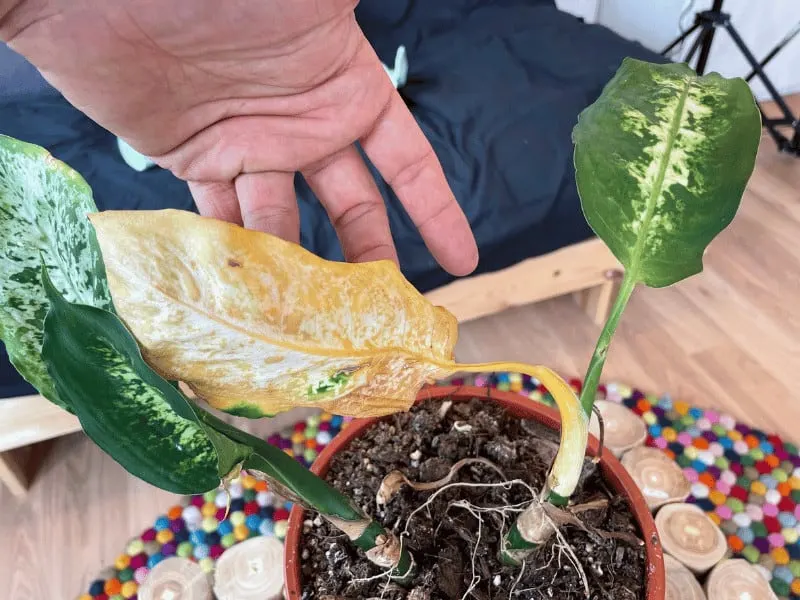
Problem: BROWN SPOTS
Cause: The main reason for brown spots is fungal and bacterial diseases.
Remedy: Ensure that you have sufficient airflow. The leaves must dry quickly and cannot stay wet for too long.
Problem: DROOPY LEAVES
Cause: You may remember seeing that this plant can be sensitive to how much water it is given.
If the leaves begin to droop instead of holding their own, revise the amount of water given.
Remedy: To correct this potential problem, check the top layer of soil.
If the soil seems soggy, regularly mist until you find the right routine.
Problem: LEAVES WITH BROWN TIPS
Cause: Some Dumb Cane plant owners try to give their plants a routine amount of water so as not to overwater.
Depending on their method, the leaves tips may take on a brown hue.
When this happens, it is likely because they are watering at the wrong times.
Environmental factors often can change the regularity of watering.
Remedy: If you see brown tips, check that your plant isn’t sitting in water.
If this happens, consider adjusting the drainage hole.
Problem: CURLED LEAVES
Cause: Another potential problem that you may find with your Dumb Cane plant is when the leaf edges start to curl inwards.
This is commonly due to the addition of excessive fertilizer.
Remember that these houseplants do not need any food during the colder months.
Read more about curled leaves on a Dumb cane.
Remedy: Solve this phenomenon by flushing away any fertilizer with clean water. This can be done over time to avoid overwatering.
5 TIPS TO KEEP YOUR DUMB CANE HAPPY
Now that you know about some of the problems that may occur, let’s focus on how to keep your new tropical addition happy and healthy.
Read the following section to ensure that your flashy plant stays beautiful.
1. Keep your plant in areas of the house with ample light that is low and indirect. Living rooms and kitchens are ideal, as they are not tucked in the corner.
2. For the temperature, try to keep your Dumb Cane in an area roughly between 65 and 75 degrees Fahrenheit. Avoid putting this plant in areas that are exposed to colder drafts.
3. Place these individuals in pots that drain properly, providing enough water to moisten the soil.
4. Give your Dumb Cane plant fertilizer during the growing seasons and stop when the colder months come around.
5. Repotting should be done about once per year. Wear gloves and sterilize all tools, as these plants are poisonous.
You can read more about Leopard lily mistakes here.
Leopard Lily Pest Problems
Like other houseplants, the leopard lily suffers from pest infestations. Thrips, mealybugs, whiteflies, and mites such as spider mites are the most common bugs.
The best way to prevent pests is not getting them in the first place. I spray all my plants bi-weekly with dishwater soap and rubbing alcohol. For this, I use a spray bottle with water. I then add in a few drops of dishwater soap and rubbing alcohol.
Check your plants regularly. Check the top as well as the underside of the leaves for insects. If an infestation gets out of hand, use a systemic insecticide. You can also use neem oil, but I had limited success in the past.
Have a few questions of your own? See if we can provide any answers or solutions below.
DUMBCANE CARE OUTDOORS
The Dumbcane plant grows well outdoors in USDA hardiness zones 10-12. Outdoor care is the same as indoor care pretty much. The one thing you need to pay attention to is the sunlight. Avoid direct sunlight for multiple hours throughout the day. Semi-shade outside is best as it equals bright indirect light.
DIEFFENBACHIA VARIETIES
Some of the most common Dieffenbachia varieties are:
- Dieffenbachia seguine
- Dieffenbachia amoena
- Dieffenbachia ‘Marianne’
- Dieffenbachia ‘Tropic Snow’
- Dieffenbachia ‘Camille’
- Dieffenbachia ‘Compacta’
- Dieffenbachia ‘Exotica’
- Dieffenbachia ‘Reflector’
- Dieffenbachia ‘Tropic Marianne’
- Dieffenbachia ‘Rudolph Roehrs’
FREQUENTLY ASKED QUESTIONS ABOUT DIEFFENBACHIA CARE
Why is it named the “Dumb Cane” plant?
The name Dumb Cane is largely due to the plant’s effects when eaten by a human. The toxins in the leaves temporarily prohibit a person from talking, making them sound less competent.
How tall can a Dieffenbachia Camille get?
The Tropic Snow (Dieffenbachia camille) is one of the taller varieties of the Dumb Cane plant. It tends to grow to a height of about 4 to 5 inches with a width of 48 inches. They make an attractive indoor houseplant yet need quite a hefty pot so they don’t fall over.
What varieties of Dieffenbachia are there?
One of the reasons why people like to house the Dumb Cane is because of the many varieties. Each has its personality with a set of flashy leaves. Other than the Tropic Snow, the Rudolf Roehrs (Dieffenbachia maculata) has white spots with a creamy leaf. The Hilo (Dieffenbachia hilo) is known for its pointed leaves that are dark with lighter veins.
Is Dieffenbachia toxic?
Dieffenbachia is toxic due to the calcium oxalate crystals located in the leaves. If you were to chew the foliage of the Dumb Cane, you could experience a burning feeling followed by temporary paralysis. Keeping this plant away from children and pets can save them from any possible trips to the hospital or vet.
Can Dieffenbachia kill cats?
Although fatality cases are rare, this plant has been known to kill cats and other animals, such as dogs or rabbits. At the very least, it can swell up your pet’s airways, making breathing difficult.
CONCLUSION ABOUT DIEFFENBACHIA CARE
The Dumb Cane plant is a great tropical plant to add to your home if you want a flashy plant that requires simple care.
They tend to be slightly picky regarding their water requirements, yet they are easy to keep happy and healthy.
Just take the necessary precautions when handling your Dumb Cane plant.

Daniel has been a plant enthusiast for over 20 years. He owns hundreds of houseplants and prepares for the chili growing seasons yearly with great anticipation. His favorite plants are plant species in the Araceae family, such as Monstera, Philodendron, and Anthurium. He also loves gardening and is growing hot peppers, tomatoes, and many more vegetables.



